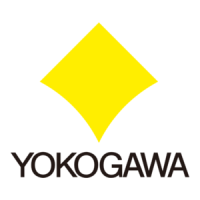
Do you have a question about the YOKOGAWA FX1006 and is the answer not in the manual?
| Type | Paperless Recorder |
|---|---|
| Input Channels | 6 channels |
| Power Supply | 100 to 240 VAC, 50/60 Hz |
| Display | 5.7-inch TFT color LCD |
| Operating Temperature | 0 to 50°C |
| Sampling Rate | 100 ms |
| Recording Interval | 1 sec to 60 min |
| External Storage | SD Card |
| Communication Interface | Ethernet |
| Measurement Range | Varies depending on input type (DCV, Thermocouple, RTD, DI) |
| Accuracy | ±0.1% of reading |
| Enclosure Rating | IP65 |
Safety symbols used on the product and in the manual.
Covers power, grounding, hazardous environments, and cover removal.
Addresses residential interference and instrument protection.
Guidelines for software, FX, and CF card handling.
Lists FX models and their available suffix codes and functions.
How to identify the FX's style, release, and firmware version.
Lists supplied and separately available accessories.
Instructions for disposing of the product according to WEEE directive.
Defines units, symbols (Warning, Caution, Note), and bold characters.
Describes input types, sampling, and data recording methods.
Overview of display types and additional functions like math, communication.
Introduction to the data display and conversion software.
Diagram showing how the FX connects within a system.
Explains terms like memory sample, display data, event data.
Identifies ports and controls on the front of the FX.
Identifies ports and terminals on the rear of the FX.
Procedures for installing and wiring the FX.
Steps for environmental and functional settings.
Steps for starting measurement and managing data.
Explains the operation of the FX's physical keys.
Describes the status and data display sections.
Icons and indicators for memory sampling status and progress.
Explains icons for alarms, key status, communication, and computation.
Icons related to CF card access, recognition, and errors.
Visual representation of transitions between operational modes.
Defines Operation, Setting, and Basic Setting modes.
How to use input windows and keys for text/numeric entry.
Detailed steps for entering character strings using keypad and soft keys.
Step-by-step instructions for inserting a CF card.
Step-by-step instructions for safely removing a CF card.
Step-by-step guide to configure the instrument's date and time.
Initial steps to configure temperature measurement settings.
Details on setting the lower and upper limits for temperature input.
Step-by-step guide for setting measurement channel parameters.
Setting span values and channel tags for temperature measurement.
Setting input range and alarm conditions for flow rate.
Procedure to set the tag for the flow rate measurement channel.
Steps to assign channels to specific display groups.
Configures the time per division for the trend waveform display.
Procedure to save the current FX configuration to a CF card.
Step-by-step guide to start memory sampling.
Step-by-step guide to stop memory sampling and computation.
How to switch between trend, digital, bar graph, and groups.
Procedure to register the word "START" as message number 1.
How messages appear on the trend display during data sampling.
Setting the FX's IP address and subnet mask.
Setting the PC's IP address and subnet mask for monitoring.
Procedure to enable the FX's web server for browser access.
Steps to access and view the FX screen via a web browser.
Procedure to save the network and web server configuration settings.
Verifying connectivity between the PC and the FX.
Final steps to display the FX screen on the PC browser.
Procedure to display measured data files using DAQSTANDARD Viewer.